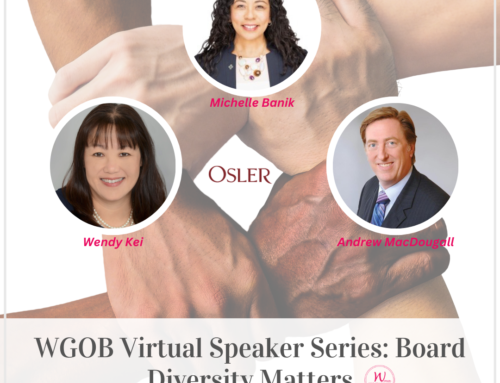Allyship is considered a leading strategy for supporting diversity and ensuring a culture of inclusion within an organization. But as a board member, how do you foster a culture of allyship within the organizations you oversee?
That’s the question speakers explored during Women Get On Board Inc. (WGOB)’s recent virtual event on allyship, sponsored by BMO. During the event, business and board leaders discussed how to be an ally, build allies and promote a culture of allyship.
Deborah Rosati, Founder & CEO of WGOB, opened the conversation, and Steven Jensen, Head of Diversified Industries, Corporate Finance, BMO Commercial Bank, introduced the speakers:
- Gavriella Schuster, Board Executive and DEI Advocate
- Glenn Keeling, Executive Chair, Alliance Advisors
- Andrew Hung, Senior Vice President & Head, Mid Market, BMO Commercial Bank
To introduce the topic, Gavriella provided an overview of what allyship means and how allies can support their colleagues.
Gavriella has worked in high tech—an industry substantially lacking in gender diversity—for the past 30 years. Throughout her career, she has frequently been the only woman in a room full of men and experienced challenges her male colleagues never had to face. How did she survive and grow her career despite these headwinds?
“Ultimately, what helped me were the allies along the way,” said Gavriella. “The people along the way who allowed me to become a better leader, who gave me the space to speak up, to share my opinion, to try and fail, and try again at various things, and supported me throughout my career.”
Why does allyship matter?
Diversity adds value and creates stronger teams. A study from McKinsey in 2020 showed that diverse workplaces had a 48% higher likelihood of outperformance, a 27% higher likelihood of value creation, and 19% higher profitability.
However, to unlock the benefits of diversity, companies must ensure they are also practicing inclusion. If individuals don’t feel comfortable speaking up, they won’t have the opportunity to share the benefits of their diverse perspectives.
That’s where allyship comes in. Individuals practice allyship when they recognize their own privilege, power and position in an organization or group and work to share it. They use their influence and power to empower others.
“Allyship, in my opinion, is at the core of inclusion,” said Gavriella.
She explained that when organizations foster a culture of allyship, they encourage a sense of inclusion, unleashing diversity’s benefits. Ultimately, it creates a better workplace for everyone, from the mailroom to the C-suite.
What are the core behaviours of an ally?
Inclusion is inhibited when marginalized group members—based on gender, race, sexual preference, or ethnicity—experience indirect, subtle or unintentional discrimination. Such moments can make those individuals feel unwelcome and may prevent them from sharing their perspectives in the future.
Allyship is key to combating inclusion inhibitors. To break down the core behaviours of an ally, Gavriella introduced the acronym ALLIES:
Advocate: Be aware of microaggressions and respond in the moment to turn a moment of exclusion into a moment of inclusion without placing blame or shame.
Listen: Be curious and listen to connect, learn and understand the perspectives of others.
Lift: Shine a spotlight on the accomplishments of others.
Include: Recognize when someone may have been inadvertently excluded and take steps to include them (if they wish to be included).
Elevate: Provide marginalized individuals with opportunities to be more visible where possible.
Sponsor: Once you get to know someone well, put your own credibility on the line to open doors for them.
What does allyship look like?
Following her presentation, the panellists joined Gavriella to discuss what allyship can look like in practice.
Over his 27-year career in banking, Andrew observed how the support of allies helped him overcome challenges. He explained that early on, he found it difficult to find his voice at work because he had been raised to defer to authority. Through the support of colleagues, he learned to speak up and share his perspective. Now, he is proud to do the same for others.
“When I found my voice, I found that I could then also lend my voice to help other people,” he said.
He noted that not only does allyship improve workplace culture, but it can impact you on an individual level. As part of the discussion, he shared examples of how mentoring and sponsoring others impacted him personally, helping him become a stronger leader.
Formalized support can help individuals find allies who can help them thrive. Andrew shared a story of a woman he met at a BMO employee resource group in B.C. who faced barriers to advancement. With the help of allies from the group—including Andrew—she successfully achieved her goal of becoming a branch manager.
“To see someone be able to grow to reach their full potential and then continue to help other people—for me, that’s why allyship is very important,” he said.
Glenn said that his family instilled the value of allyship from a young age, especially his father, who taught him the importance of supporting and uplifting women. Now, in his career leading proxy firms, he has frequent opportunities to practice allyship, particularly in hiring and promoting staff. He explained that he is always eager to hire people from diverse backgrounds because he knows the value diversity brings to an organization. His philosophy is that you can teach inexperienced employees new skills, but you can’t teach a diverse perspective.
“What I can’t teach you is what you are,” he said.
How can allies speak up for others?
One of the most meaningful ways allies can support marginalized colleagues is by speaking up to recognize the moment when they have been excluded or experienced microaggressions and give them an opportunity to re-engage.
Andrew noted that it can be more difficult to speak up for others while serving on a board due to the complex dynamics. Boards meet infrequently, and people arrive at the table with varying goals, agendas, experiences and ideas.
His suggestion? Phrase your interjection as a question. For example, “Let me understand if I heard this right . . .” Then, you can follow up by respectfully explaining how the message could be phrased or framed differently. Gavriella suggests sharing these explanations in a way that builds up the experiences of others rather than tearing anyone down.
Glenn shared a poignant example from his own work in which a woman contributing a differing opinion was interrupted by a man during a large virtual meeting. To ensure the woman had the chance to speak—and to enforce the idea that all perspectives should be valued equally—Glenn redirected the conversation back to her, allowing her to finish sharing her comments.
In their closing thoughts, the speakers emphasized how allyship not only benefits marginalized individuals, but it also positively impacts allies on a personal level and creates better organizational cultures. Allyship is an opportunity to be curious, learn, support others, grow your network and become a stronger leader.
“Always be trying to help people along. It’ll come back to pay dividends,” said Glenn.





